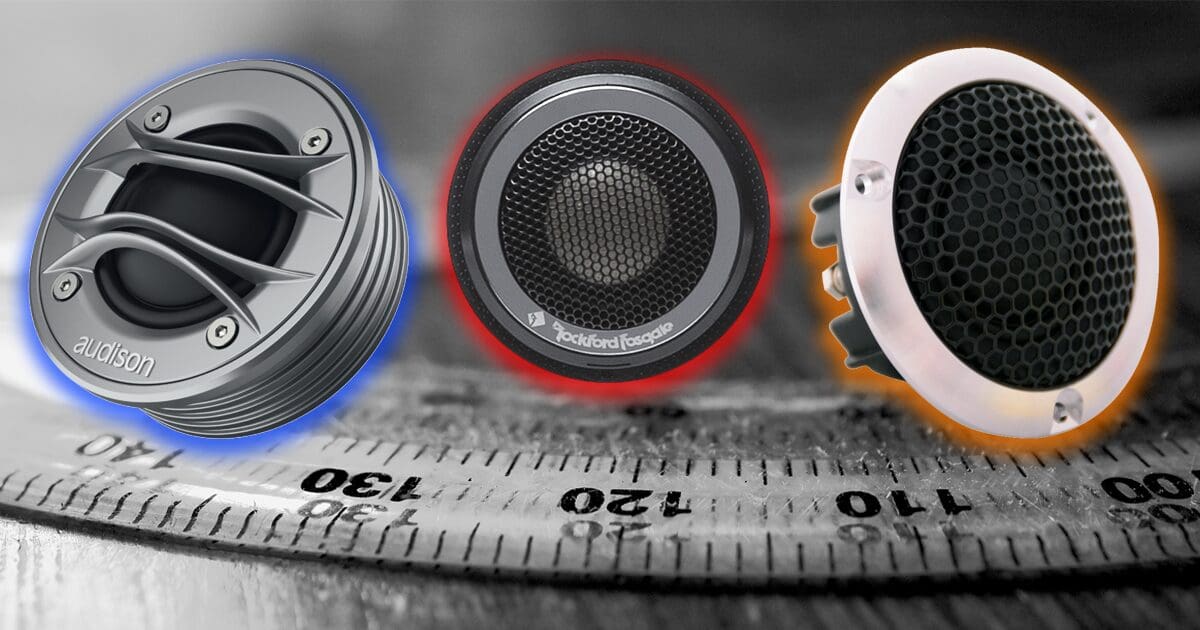The staff here at BestCarAudio.com look at dozens of installation photos each day and continue to see tweeters that aren’t installed in a way that will maximize the listening experience. Our goal is to help consumers get the best performance possible from their car audio system upgrades, so we’re going to perform two tests to demonstrate the importance of understanding speaker dispersion patterns. This information is vital to optimizing the angle at which tweeters are installed in a car audio system.
Let’s Talk About Speaker Directivity, Again
The term directivity describes where the sound created by a speaker goes. For the purposes of this article, we are going to talk specifically about tweeters. (We’ll follow up soon with another article about midrange speakers and woofers.) A clear understanding of these concepts for all speaker sizes is crucial to proper car audio system design and installation.
As a caveat, we want to make it clear that directivity occurs with every type of speaker from every company at every price point. Inexpensive speakers are no different from those that cost thousands of dollars. For this test, we used a 1.5-inch audiophile-grade automotive tweeter. We choose this driver because we know it has a flat response and minimal distortion.
When we talk about speaker directivity, we need to compare the circumference of a speaker to a wavelength of sound. Wavelength is calculated by dividing the speed of sound (343 meters per second) by frequency. As an example, a 1 kHz tone has a wavelength of 34.3 centimeters or about 13.5 inches. A 40 hertz tone is 8.575 meters or 337.6 inches. The length of the pipes in a church organ is calculated using this wavelength information. The same holds for wind instruments like trombones or trumpets.
For speakers playing low frequencies relative to their circumference (and proportionately, their diameter), energy radiates forward, backward, sideways, up and down. You can think of this in the same way that light radiates from a candle. Candles aren’t brighter to the side or above. The light created by a candle is a point source that radiates outward and evenly in all directions.
At extremely high frequencies, sound radiates from the speaker similarly to light from a flashlight. If you are off to the side of a narrow-beam flashlight, you won’t be illuminated. For speakers, the same thing happens. Off to the side of a speaker, high-frequency information can be attenuated by 24 decibels or more compared to being directly in front of the speaker.
Speaker Diameter Affects Directivity
The directivity characteristics of a speaker depend on the size of the speaker cone or diaphragm. Keep in mind that the advertised “size” of a woofer or midrange doesn’t describe the diameter or circumference of the actual speaker cone. For example, a 6.5-inch speaker doesn’t have a cone with a diameter of 6.5 inches. It’s usually closer to five.
For our 1.5-inch tweeter, the diaphragm has a circumference of roughly 4.712 inches, which is the wavelength of 2.865 kHz tone. Each speaker has a unitless value known as ka. The ka value is the driver’s circumference divided by wavelength. Directivity can be described as multiples of ka. For our tweeter, ka is equal to 4.712 kHz; ka = 0.5 is 1.43 kHz; ka = 2 would be 5.7 kHz; and ka = 5 would be 14.3 kHz. Above a frequency where ka = 1, the speaker becomes increasingly directional. Below this frequency, sound radiates evenly in all directions — even behind the speaker.
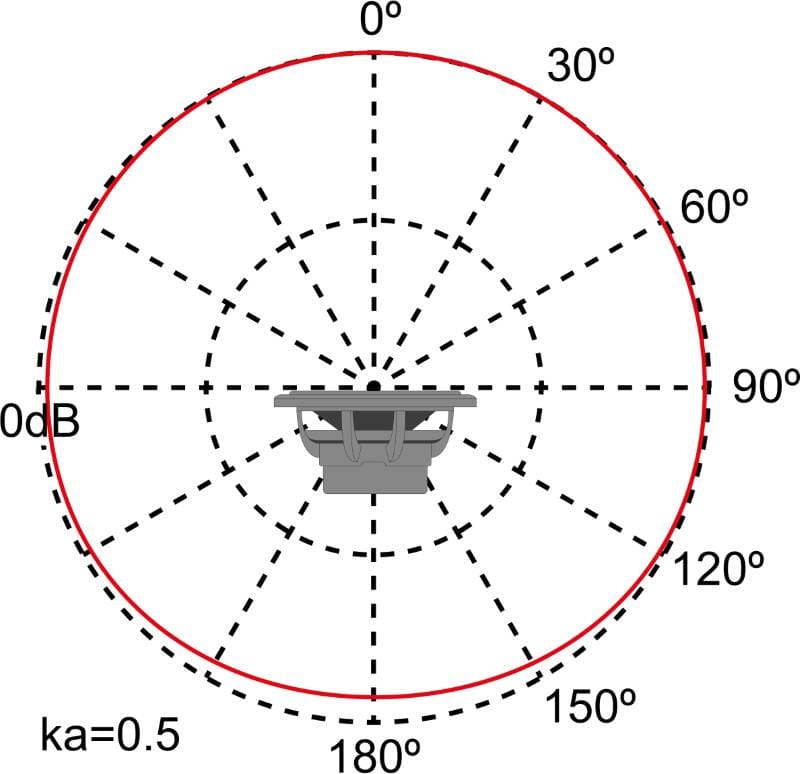
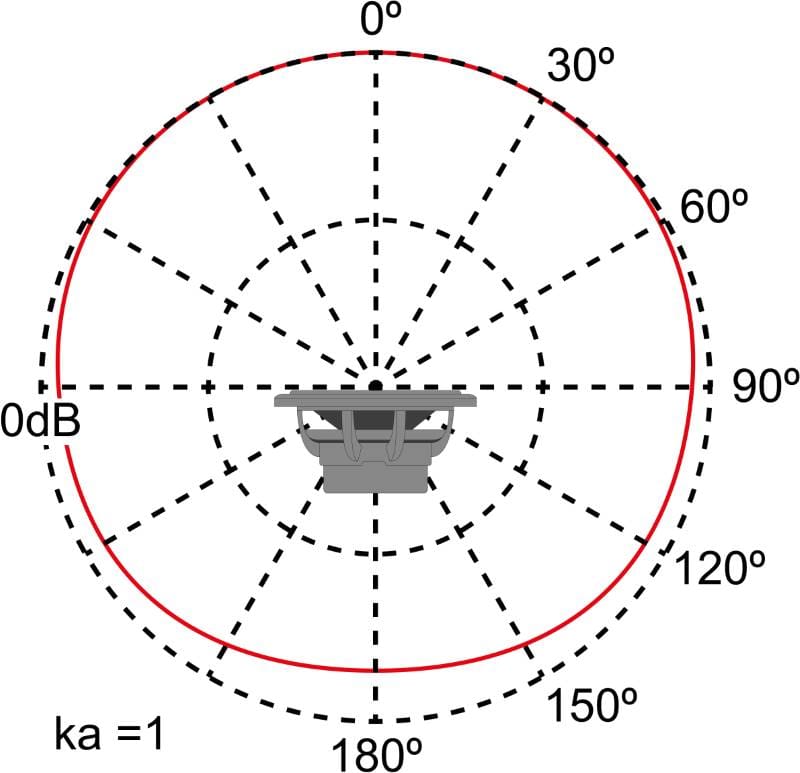
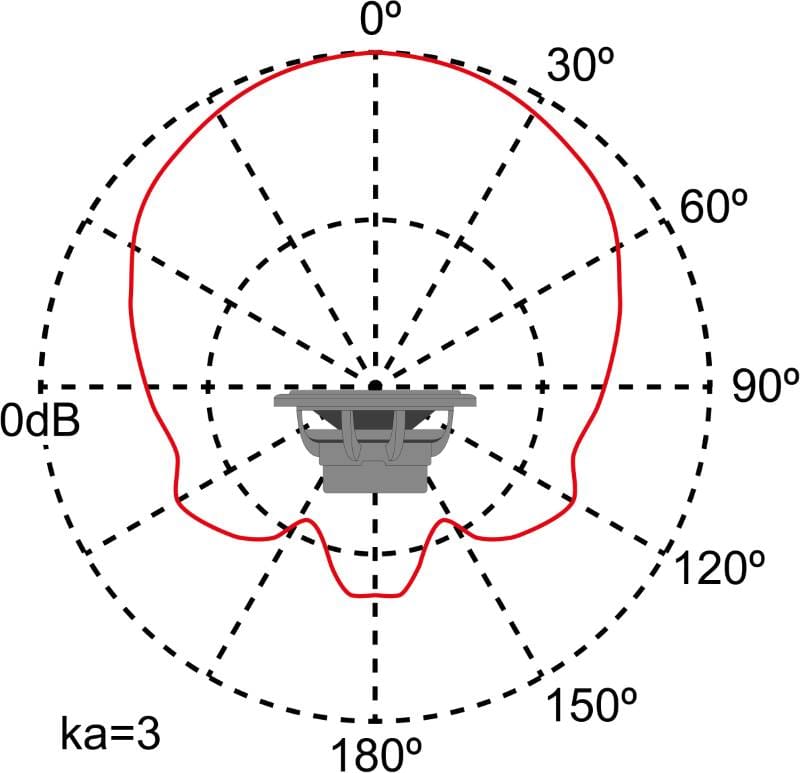
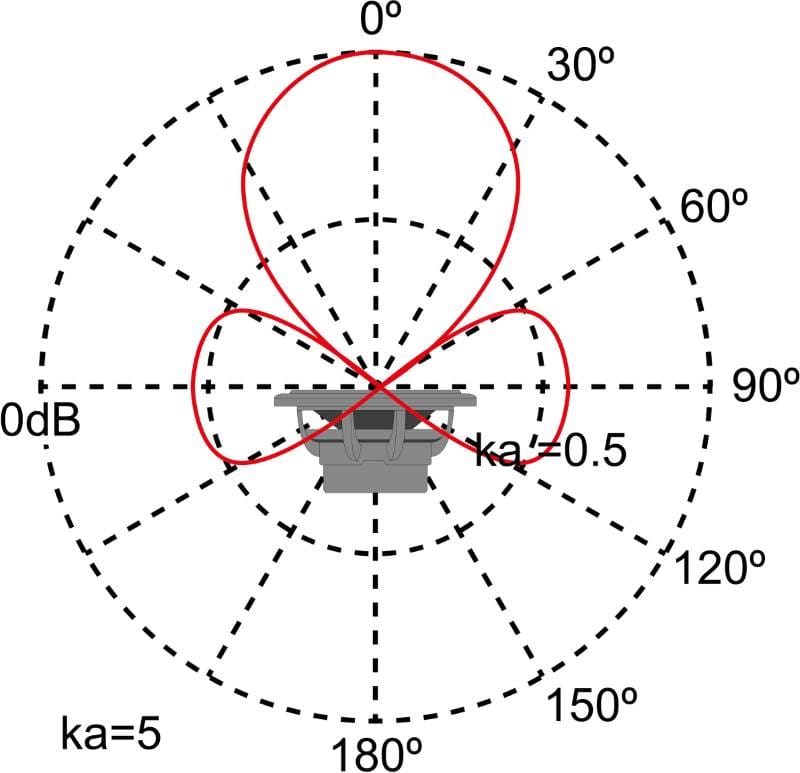
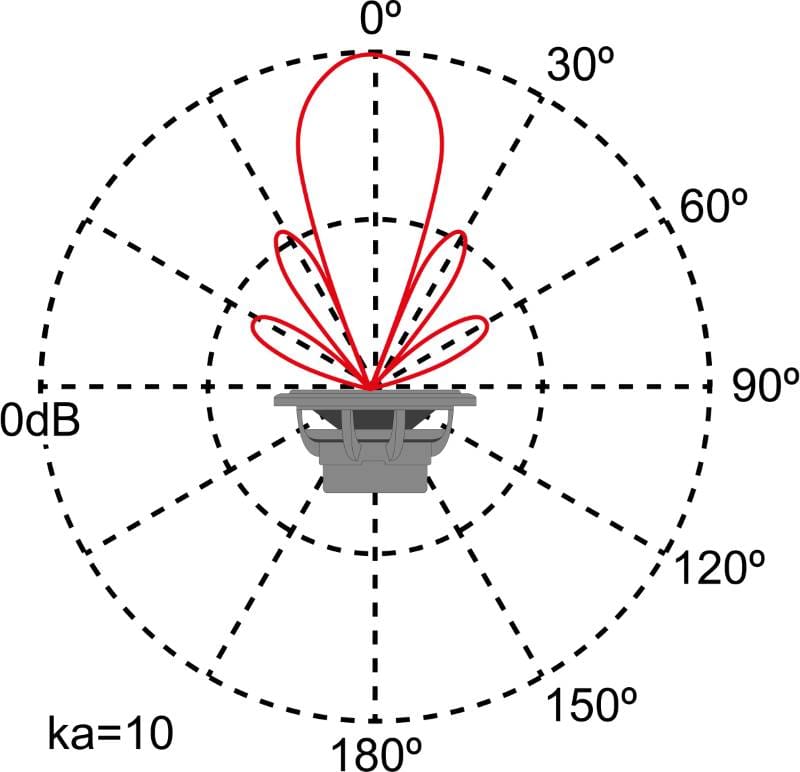
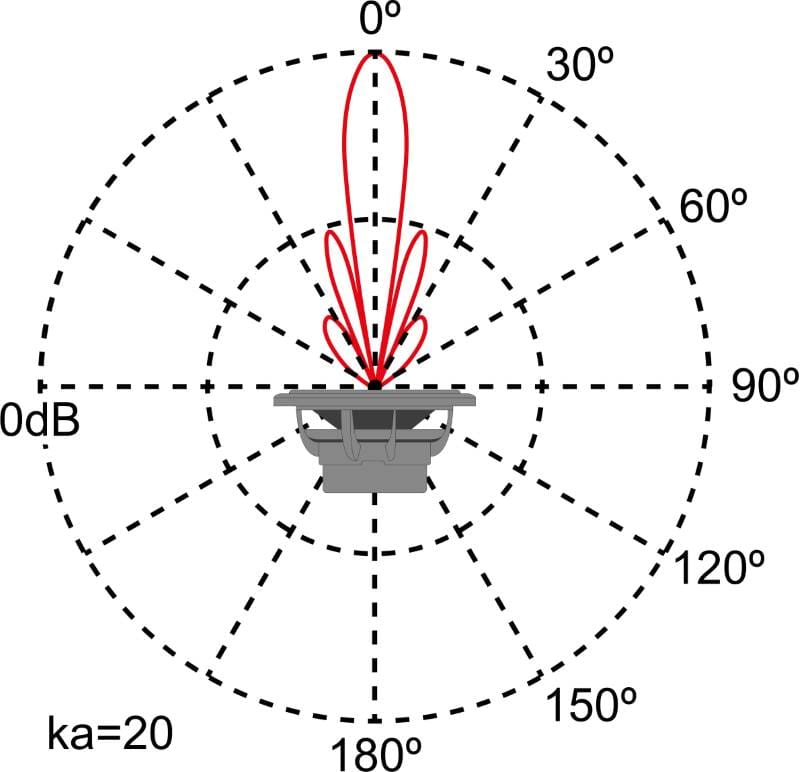
The graphs above represent a generalization of how the output of a speaker changes as you move off-axis from being directly in front of the driver. As can be seen in ka values of 1 or less, you would hear almost as much of that frequency when standing behind a speaker as you would being directly in front of it. By the time ka = 3, you don’t hear anywhere near as much to the speaker’s side, and it only gets worse as frequency increases.
Directivity Testing
We set the tweeter up on a pedestal and took a series of measurements at 12-degree increments. The graph below shows how the tweeter output decreases at high frequencies as the listing angle increases.
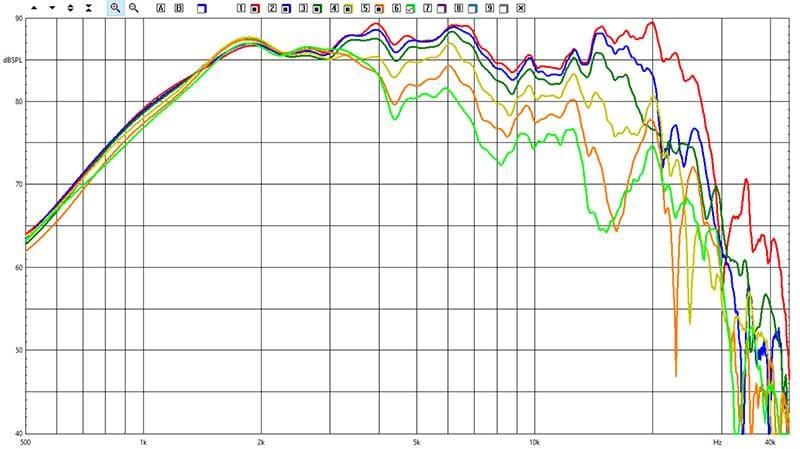
The red trace represents being directly in front of the speaker. Frequency response is within 5 dB from 1.5 kHz to above 20 kHz. Since we don’t have an anechoic chamber and are using windowed FFT measurements, these are adequately accurate results for this article.
The blue line has the microphone positioned 12 degrees to the side and directly on-center. At a meter, that’s a distance of only 20.9 centimeters or roughly 8.2 inches to the side. There are some minor changes in response up to 15 kHz of about 1 dB. At 20 kHz, the output has decreased by about five dB.
The dark green trace now has the microphone located 24 degrees off-axis. Overall output is down another dB or two between 3kHz and 15kHz, but the output at 20 kHz is down 13 dB. As we move farther and farther to the tweeter side, the output decreases more and more.
Think back to the math we did to calculate that ka = 1 frequency of 2.865 kHz. All the frequency response measurements are nearly identical at that frequency and below, and they start to separate more and more at multiples of that frequency. It’s almost like the math works!
Option 2 – The Tweeter Bounce
It’s not always physically easy to position a tweeter so it aims equally at the driver and passenger. One option in these instances is to install the tweeter near the base of the windshield and point it upward. The sound from the tweeter will bounce off the glass and radiate into the listening area.
While this sounds ideal, there are drawbacks. In this configuration, you effectively have two sound sources with different path lengths. This difference in path lengths will cause a certain amount of constructive and destructive interference called comb filtering.
The graph below shows the response of our audiophile tweeter at zero degrees in red, at 48 degrees in blue and measurement at 90 degrees off-axis in green. The fourth measurement is still at 90 degrees, but we have added a large piece of glass in front of the tweeter and angled it at 45 degrees. This last trace is in gray and shows us the measured response off of the glass.
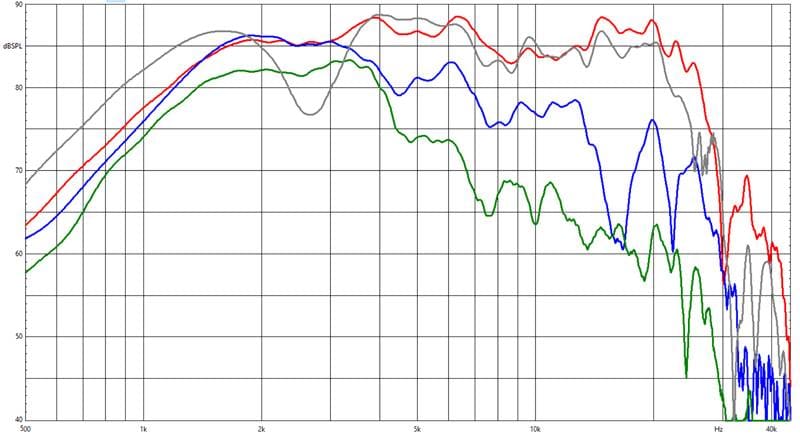
Bouncing the tweeter output off our windshield analog, the response above 4 kHz is as good as if the tweeter were installed on-axis directly with the listening. But, unfortunately, everything comes with a price. We now have a dip of about 8 dB at 2.7 kHz. Yes, we could fix that with an equalizer, but that would require driving the tweeter with more than six times as much power around that frequency range. We could raise the crossover point to 3.5 kHz, but now we might have frequency response problems with the high-frequency information from the midrange speaker.
The Takeaway on Aiming Tweeters
If you want to hear all the music your stereo reproduces, then it would be ideal to be within plus or minus 15 degrees of on-axis with the tweeters in your car audio system. Any effort you might have put into reproducing the highest audio frequencies with better amplifiers or high-resolution audio players is lost if you are beyond that angle. You can also explore how your system behaves with the tweeters in the corners of the dash. You’ll sacrifice a bit of stage width and may have to deal with some frequency response issues at lower frequencies than sail panel locations, but it might require less fabrication.
We’d never argue that installers and technicians have different tuning and installation methods. With that said, and in spite of their best efforts, they can’t change the laws of physics. Choosing a tweeter location that has both of the tweeters pointed at the middle of the car between the driver and passenger’s head will ensure both can enjoy extended frequency response with good symmetry from both sides of the vehicle. Drop by your local specialty mobile enhancement retailer today to discuss how they can aim the tweeters in your car or truck for the best performance.
